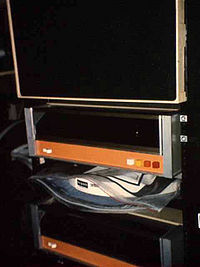Difference between revisions of "RK02/03 disk drive"
From Computer History Wiki
m (+links) |
(Move addn'l data to infobox) |
||
| Line 4: | Line 4: | ||
| capacity = 1.22 Mbytes (RK02)<br>2.45 Mbytes (RK03) | | capacity = 1.22 Mbytes (RK02)<br>2.45 Mbytes (RK03) | ||
| controller = [[RK8E]] ([[Omnibus]])<br>[[RK11|RK11-C]] ([[UNIBUS]]) | | controller = [[RK8E]] ([[Omnibus]])<br>[[RK11|RK11-C]] ([[UNIBUS]]) | ||
| + | | average access time = 70 msec | ||
| rpm = 1500 | | rpm = 1500 | ||
| + | | revolution time = 20 msec | ||
| + | | one track seek - 15 msec | ||
| + | | average seek - 70 msec | ||
| + | | aaximum seek - 135 msec | ||
| surfaces = 2 | | surfaces = 2 | ||
| + | | tracks per surface = 203 (nominally 200, plus 3 spares) | ||
| sectors per track = 16 (RK8E)<br>12 (RK11) | | sectors per track = 16 (RK8E)<br>12 (RK11) | ||
| words per sector = 128 (RK02-RK11)<br>256 (RK03-RK11) | | words per sector = 128 (RK02-RK11)<br>256 (RK03-RK11) | ||
| Line 12: | Line 18: | ||
| recording method = Double Frequency | | recording method = Double Frequency | ||
| transfer rate = 22.2 μsec/word (RK02-RK11)<br>11.1 μsec/word (RK03-RK11) | | transfer rate = 22.2 μsec/word (RK02-RK11)<br>11.1 μsec/word (RK03-RK11) | ||
| + | | physical size - 19" W x 10.5" H x 26.0" L | ||
| + | | weight - 43 pounds (basic Diablo drive) | ||
}} | }} | ||
| + | |||
| + | [[Image:rk03.jpg|200px|thumb|left|RK03 drives]] | ||
The '''RK02''' and '''RK03''' were moving-head removable-pack [[magnetic storage]] [[disk]] drives, sold by [[DEC]], but designed and manufactured by [[Diablo Systems]]. They were inspired by the IBM 2315 drive and pack. | The '''RK02''' and '''RK03''' were moving-head removable-pack [[magnetic storage]] [[disk]] drives, sold by [[DEC]], but designed and manufactured by [[Diablo Systems]]. They were inspired by the IBM 2315 drive and pack. | ||
| Line 20: | Line 30: | ||
The pack contained a [[platter]] 14 inches in diameter, coated with iron oxide. Since the disk was hard [[sector]]ed, platters used in the PDP-8 were physically incompatible with those used in the PDP-11, although the drives themselves were completely identical for both. | The pack contained a [[platter]] 14 inches in diameter, coated with iron oxide. Since the disk was hard [[sector]]ed, platters used in the PDP-8 were physically incompatible with those used in the PDP-11, although the drives themselves were completely identical for both. | ||
| − | == | + | ==External links== |
| − | |||
| − | |||
| − | |||
| − | |||
| − | |||
| − | |||
| − | |||
| − | |||
| − | |||
| − | |||
| − | |||
| − | |||
* [http://maben.homeip.net/static/s100/diablo/disks/Diablo%2081502A%20Model%2030%20disk%20drive.pdf Series 30 Disk Drives] | * [http://maben.homeip.net/static/s100/diablo/disks/Diablo%2081502A%20Model%2030%20disk%20drive.pdf Series 30 Disk Drives] | ||
* [http://chmhdd.wikifoundry.com/page/Diablo+30+Series Diablo 30 Series] | * [http://chmhdd.wikifoundry.com/page/Diablo+30+Series Diablo 30 Series] | ||
[[Category: DEC Disk Drives]] | [[Category: DEC Disk Drives]] | ||
Revision as of 20:07, 2 October 2017
| RK02/RK03 | |
| Manufacturer: | Diablo Systems |
|---|---|
| Drive Controller(s): | RK8E (Omnibus) RK11-C (UNIBUS) |
| Capacity: | 1.22 Mbytes (RK02) 2.45 Mbytes (RK03) |
| Transfer Rate: | 22.2 μsec/word (RK02-RK11) 11.1 μsec/word (RK03-RK11) |
| Average Access Time: | 70 msec |
| Revolutions per Minute: | 1500 |
| 1/2 Revolution Time: | 20 msec |
| Total Surfaces: | 2 |
| Words per Sector: | 128 (RK02-RK11) 256 (RK03-RK11) |
| Tracks per Inch: | 100 |
| Density: | 1100 bpi(RK02) 2200 bpi (RK03) |
| Recording Method: | Double Frequency |
The RK02 and RK03 were moving-head removable-pack magnetic storage disk drives, sold by DEC, but designed and manufactured by Diablo Systems. They were inspired by the IBM 2315 drive and pack.
The original RK02 (Diablo Model 30) was soon joined by the RK03 (Diablo Model 31), a double-density model which held twice as much data.
The pack contained a platter 14 inches in diameter, coated with iron oxide. Since the disk was hard sectored, platters used in the PDP-8 were physically incompatible with those used in the PDP-11, although the drives themselves were completely identical for both.
